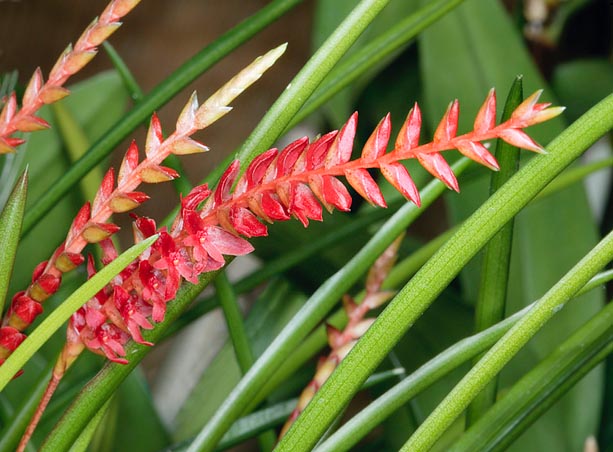Family : Orchidaceae

Text © Pietro Puccio

English translation by Mario Beltramini

The Dendrochilum wenzelii has 4-9 cm inflorescences carried by a long peduncle © Giuseppe Mazza
The name of the genus is the combination of the Greek terms “déndron” = tree and “cheilos” = lip, with reference to its epiphytic nature and to the prominent labellum; the species is honoured to the orchids collector Rafael Wenzel.
Common names: red chain orchid, Wenzel’s chain orchid (English).
The Dendrochilum wenzelii Ames (1915) is an evergreen species with fusiform, close together, pseudobulbs, 1,2-3 cm long and with a diameter up to 0,5 cm, furnished with one only linear leaf, coriaceous, with pointed apex, 15-40 cm long and 0,2-0,5 cm broad.
The inflorescences, which develop at the same time as the new pseudobulb and the new leaf, are curved, 4-9 cm long, on an 8-30 cm long peduncle, with up to 30 tiny alternate flowers, close together, regularly placed in two rows, of a usually bright red colour, less frequently, greenish yellow.
The sepals are 4-5 mm long, the dorsal one is about 1 mm broad, whilst the lateral ones are 2 mm broad; the petals, ovate, are 2-3 mm long and 1-2 mm broad; the labellum is trilobate, about 1 mm long and 2-3 mm broad.
The flowers, in spring, are relatively long-lasting, three weeks about. It reproduces by seed, in vitro, and by division.

The alternate small flowers are tiny and the pseudobulbs have one linear leaf only © Giuseppe Mazza
The waterings are to be regular in summer, slightly less in winter, but without having the compost to dry up; for the waterings and the nebulisations are to be used rainwater, or water obtained by reverse osmosis or demineralised and the fertilizations, duly distributed in way to avoid salts accumulations, are to be done preferably with balanced hydro-soluble products, with microelements, at a ¼ of the dosage suggested on the package.
It can be cultivated in pot or in a basket, with draining compost which may be formed by fragments of finely cut bark, charcoal and sphagnum. It does not love to be disturbed; therefore repottings and divisions are to be done only when strictly necessary, by the time of the vegetative renewal.
The species is inscribed into the appendix II of the CITES (species whose trade is internationally ruled).
Synonyms: Acoridium wenzelii (Ames) Ames (1922).
→ For general notions about ORCHIDACEAE please click here.
